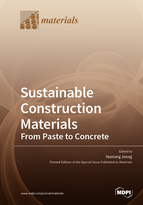Sustainable Construction Materials: From Paste to Concrete
A special issue of Materials (ISSN 1996-1944). This special issue belongs to the section "Construction and Building Materials".
Deadline for manuscript submissions: closed (31 December 2022) | Viewed by 51882
Special Issue Editor
Special Issue Information
Dear Colleagues,
With increasing attention on the reduction of CO2 emissions, the sustainability of construction materials has become one of the most growing issues in concrete science and engineering research fields. New sustainable construction materials, such as alkali-activated materials, calcium sulfoaluminate (CSA) cement, and limestone calcined clay cement (LC3), have been suggested and high-performance and/or highly durable construction materials using special admixtures, such as nanomaterials, have been studied to reduce the environmental impact during the life cycle of construction materials.
This Special Issue aims to highlight and share recent findings in developing new sustainable cementitious materials, modeling their hydration kinetics, investigating their microstructure, improving the performance and durability of cementitious materials using functional supplementary ingredients, suggesting novel test methods for new construction materials, etc. This Special Issue calls for papers on the following, but not limited to, areas:
- Sustainable concrete and alternative binders;
- Hydration kinetics of sustainable cementitious materials;
- Characterization of sustainable cementitious materials;
- Re-utilization of industrial by-products for construction materials;
- High strength and durable cementitious materials;
- Property enhancement by functional additives;
- Energy storage through construction materials;
- Evaluation of environmental impact of new construction materials.
It is my great pleasure to invite you to submit a manuscript for publication in this Special Issue.
Dr. Yeonung Jeong
Guest Editor
Manuscript Submission Information
Manuscripts should be submitted online at www.mdpi.com by registering and logging in to this website. Once you are registered, click here to go to the submission form. Manuscripts can be submitted until the deadline. All submissions that pass pre-check are peer-reviewed. Accepted papers will be published continuously in the journal (as soon as accepted) and will be listed together on the special issue website. Research articles, review articles as well as short communications are invited. For planned papers, a title and short abstract (about 100 words) can be sent to the Editorial Office for announcement on this website.
Submitted manuscripts should not have been published previously, nor be under consideration for publication elsewhere (except conference proceedings papers). All manuscripts are thoroughly refereed through a single-blind peer-review process. A guide for authors and other relevant information for submission of manuscripts is available on the Instructions for Authors page. Materials is an international peer-reviewed open access semimonthly journal published by MDPI.
Please visit the Instructions for Authors page before submitting a manuscript. The Article Processing Charge (APC) for publication in this open access journal is 2600 CHF (Swiss Francs). Submitted papers should be well formatted and use good English. Authors may use MDPI's English editing service prior to publication or during author revisions.
Keywords
- construction materials
- green concrete
- alternative binder
- microstructure
- sustainability
- high strength
- high durability







